The restoration of the Vecchia, a masterpiece by Giorgione (Castelfranco Veneto, 1478 - Venice, 1510),has been completed . The work, kept at the Gallerie dell’Accademia in Venice, will remain admired by the Venetian public for a few days before leaving for the United States: it will be in Ohio, at the Cincinnati Art Museum, from February 15 to May 5, and then in Connecticut, at the Wadsworth Atheneum in Hartford, from May 15 to August 4. The work’s restoration was conducted by Giulio Bono with the collaboration of Silvia Bonifacio, under the direction of Giulio Manieri Elia and Maria Chiara Maida and, for scientific investigations, Ornella Salvadori. The operations were funded by the Foundation for Italian Art & Culture, as part of an agreement signed with the museum aimed at increasing the visibility of the Gallerie dellAccademia in the world. What follows is the official technical note of the restoration, which we present in full given the complexity of the restoration and the importance of the masterpiece.
Giorgione’s Vecchia restored
Giorgione’s Vecchia, originally belonging to the collection of Gabriele Vendramin and landed at the end of the 18th century (after various collecting passages) in the collections of Girolamo Manfrin, entered the holdings of the Gallerie dellAccademia in 1856 through purchase by the Austrian government. We do not possess Conservative information or news of ancient restoration prior to Mauro Pellicioli’s intervention in 1948, however, some information can be drawn from historical photographic documentation.
The oldest conservative information
The first of these images is a shot taken by Carlo Naya in the late 19th century. Giorgion’s masterpiece appears extensively repainted, especially: on the forehead, nose, cheek (to the right of the viewer) and at the height of the neck attachment of theffigiata as well as on the balustrade in the foreground. These are, after all, areas that we know today as the most worn due to probable effect of old cleaning interventions, covered, due to their conservative state, with the pictorial additions we see in the photograph. Already clearly visible is the scratch that, slightly diagonally, proceeds from the ear on the right to the black background of the painting on the left. In better preserved condition, however, appear the robe, shawl and headdress. There is no change, in substance, in the conservation appearance evident in the later shot of the early twentieth-century Anderson Agency. The sharpness of the image facilitates, however, lanalysis of conservation by making better definable the areas with overpainting and coarse repainting that accentuate the senescence effects of the effigy especially in the dark areas of the cheek and neck.
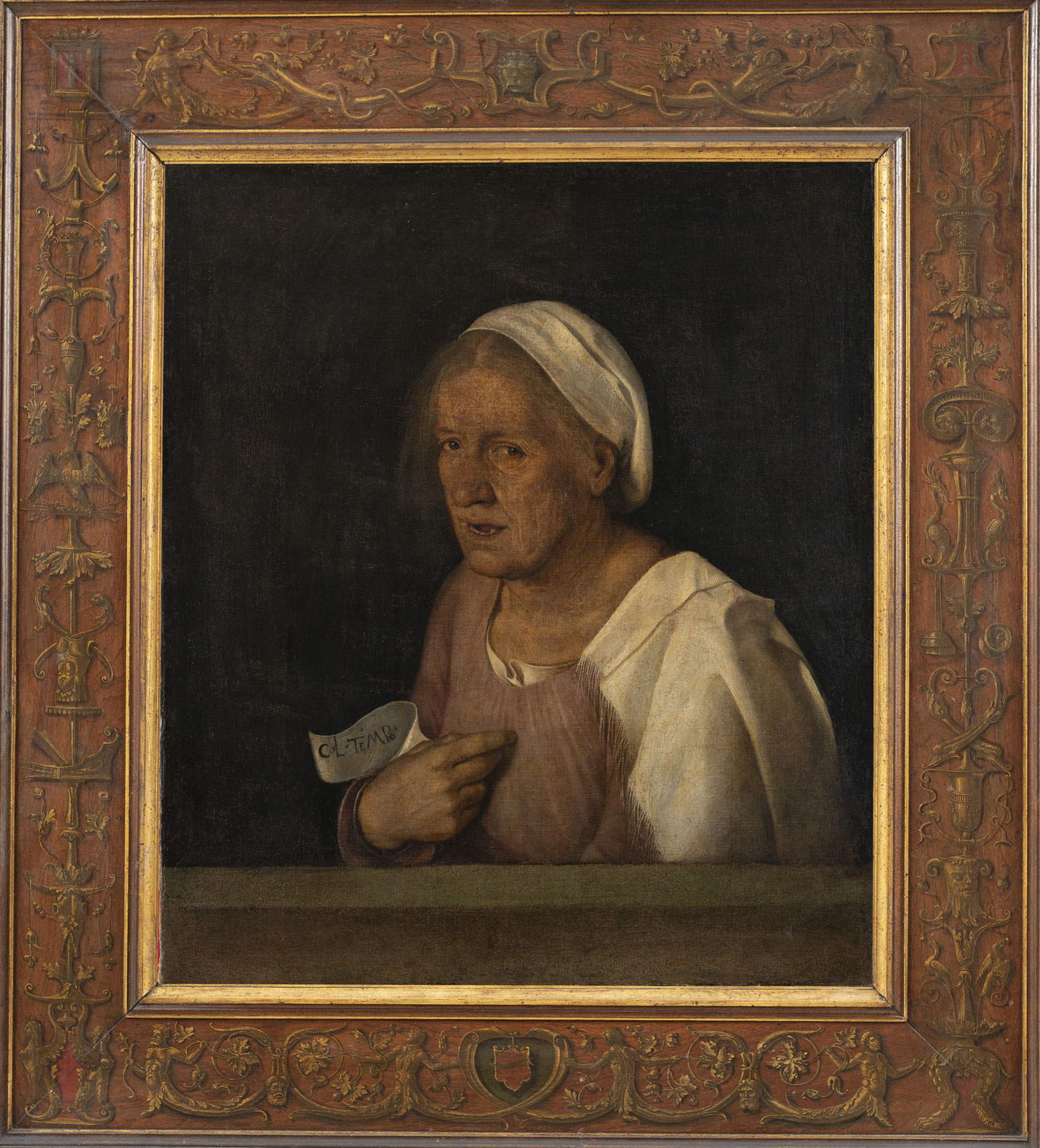 |
| Giorgione, La Vecchia, before restoration (painting on canvas, 68.4 x 59.5 cm; Venice, Gallerie dell’Accademia). GAve photo archive - courtesy of the Ministry of Cultural Heritage and Activities and Tourism, National Museum Gallerie dellAccademia, Venice. Ph. Matteo De Fina |
Restorations prior to those by Mauro Pellicioli (1948) and Ottorino Nonfarmale (1984)
In March 1948, the work underwent restoration by Pellicioli, the most celebrated Italian restorer of the 20th century; the stated intent was to restore the painting to an appearance more consistent with the Giorgionesque lutography by removing the aforementioned repainting: “eliminating old restorations and repainting,” as clarified by the documents of the time, which still recall “lattenta pulitura began from the balustrade, which appeared entirely repainted: In fact, under the dark green layer superimposed, the original lighter color appeared, which was entirely put back into the light. In other parts of the painting the intervention consisted essentially in removing the old restorations that covered damaged areas, particularly in the front of the old one.” Pellicioli intervenes by removing the repainting and exposing a strongly pronounced, open and discontinuous crack, located especially in the areas characterized by the abrasions created, as mentioned, as a result of old cleanings performed with aggressive solvents. The restorer then begins with the thinning of the ancient varnishes but, as was the practice, only locally. He proceeds, still as was customary, with the thorough cleaning of the light color backgrounds and less of the dark ones. He limits the pictorial reinstatement to only the so-called tonal lowering of the damaged or disturbing areas and goes on to apply a pigmented varnish, golden-brown in color, to mitigate the unpleasant effects of the damaged areas. The subsequent restoration work, carried out in 1984 by Ottorino Nonfarmale, motivated by the need to consolidate the pictorial film, is preceded by a complete diagnostic campaign (UV, IR, RX). It is, to all intents and purposes, a purely conservative intervention, determined by the conviction that the work had undergone a radical operation of transporting color from the original canvas to a new one. This operation would have made the color particularly vulnerable and would have generated the effects of impoverishment of the paint surface and the long cut across the front of La Vecchia caused, according to Nonfarmale, by “a careless tearing of the back of the original canvas.” The restorer then abandons the idea of uncovering the painting and proceeds by applying an additional re-covering canvas to the back; he then proceeds to clean the paint surface without removing the previous retouches, especially the varnish in contact with the original color. On it he proceeds with the pictorial intervention concluding with the varnishing and renewal of the frame.
The conservative state of the work before the current restoration
The painting had no problems with the stability of the pictorial layers or dependent on the tightness of the textile supports or their tensioning. The relevant problems concerned the impairment of the image, understanding and aesthetic appreciation of this extraordinary masterpiece. Dull and opalescent appeared to be the surface layer of varnish, covered by an accumulation of surface adhesion dirt. Underneath, older layers of paint were visible, altered, yellowed and discontinuous, as they had only been locally removed in the past. Oxidized, altered, and disturbing were the retouches made neglinterventions of the past. The original paint film appeared distressed, as a result of aggressive ancient cleaning, discontinuous, as a result of the presence of ancient retouching and the local emersion of the imprimitura or preparation. Heavily abraded were the black background and the parapet, the subject of 1948 repainting removal, as well as the headdress and shawl, which also appeared yellowed due to the presence of the pigmented patina applied by Pellicioli. The crazing appeared marked, open and discontinuous. Widespread abrasions in the face and decolletage. Conspicuous retouching lines, emphasizing the effects of senescence, very evident around the left eye. Strongly disturbing is the long cut on the forehead of the effigies. Better condition of the pink robe, though totally out of tone because it was affected by the alteration of the pigmented paint, and of the hand, except for a deep localized abrasion in the center of the back.
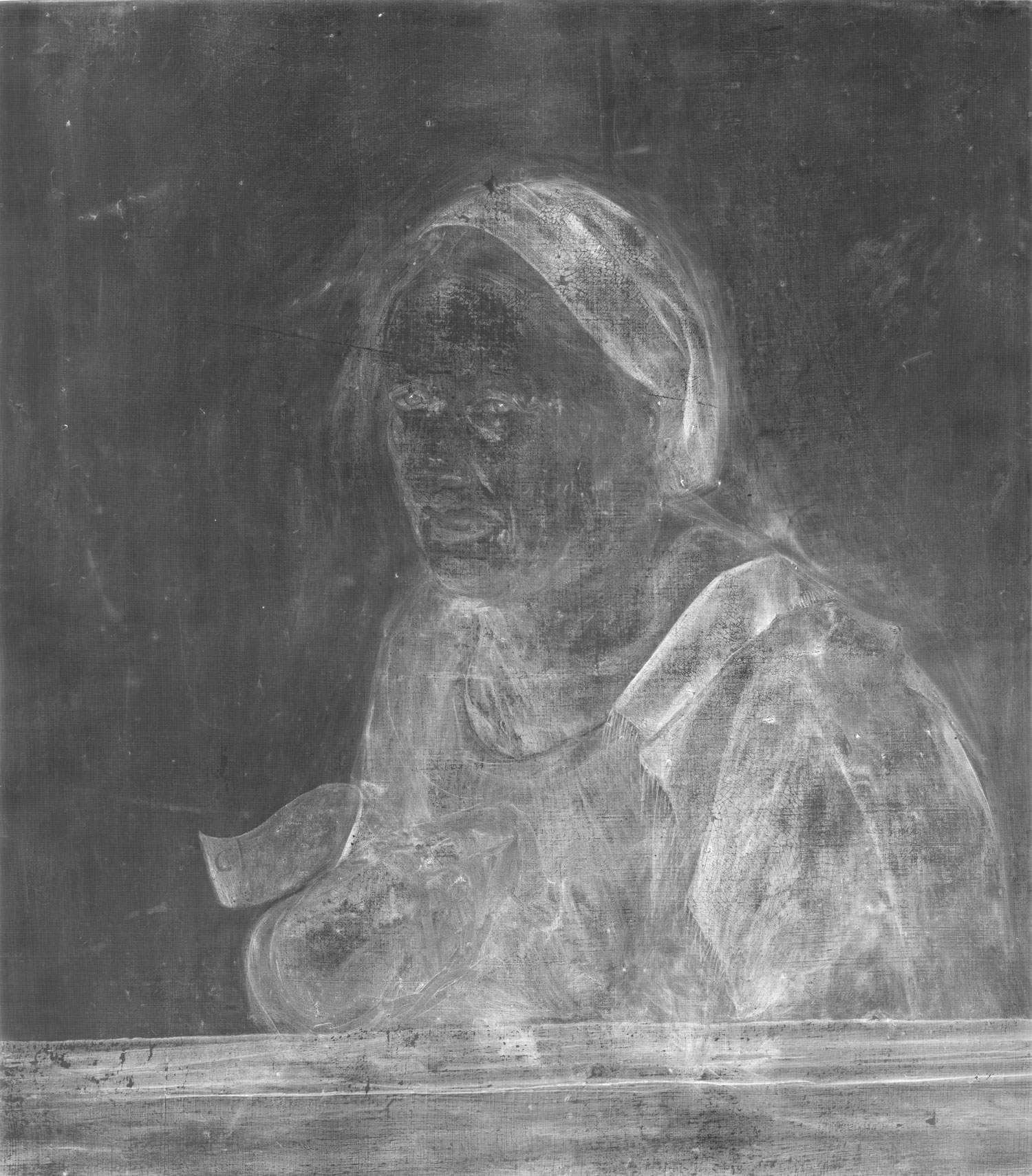 |
| Giorgione, La Vecchia, X-ray survey. GAve Photographic Archive - courtesy of the Ministry of Cultural Heritage and Activities and Tourism, National Museum Gallerie dellAccademia, Venice. RX: Davide Bussolari |
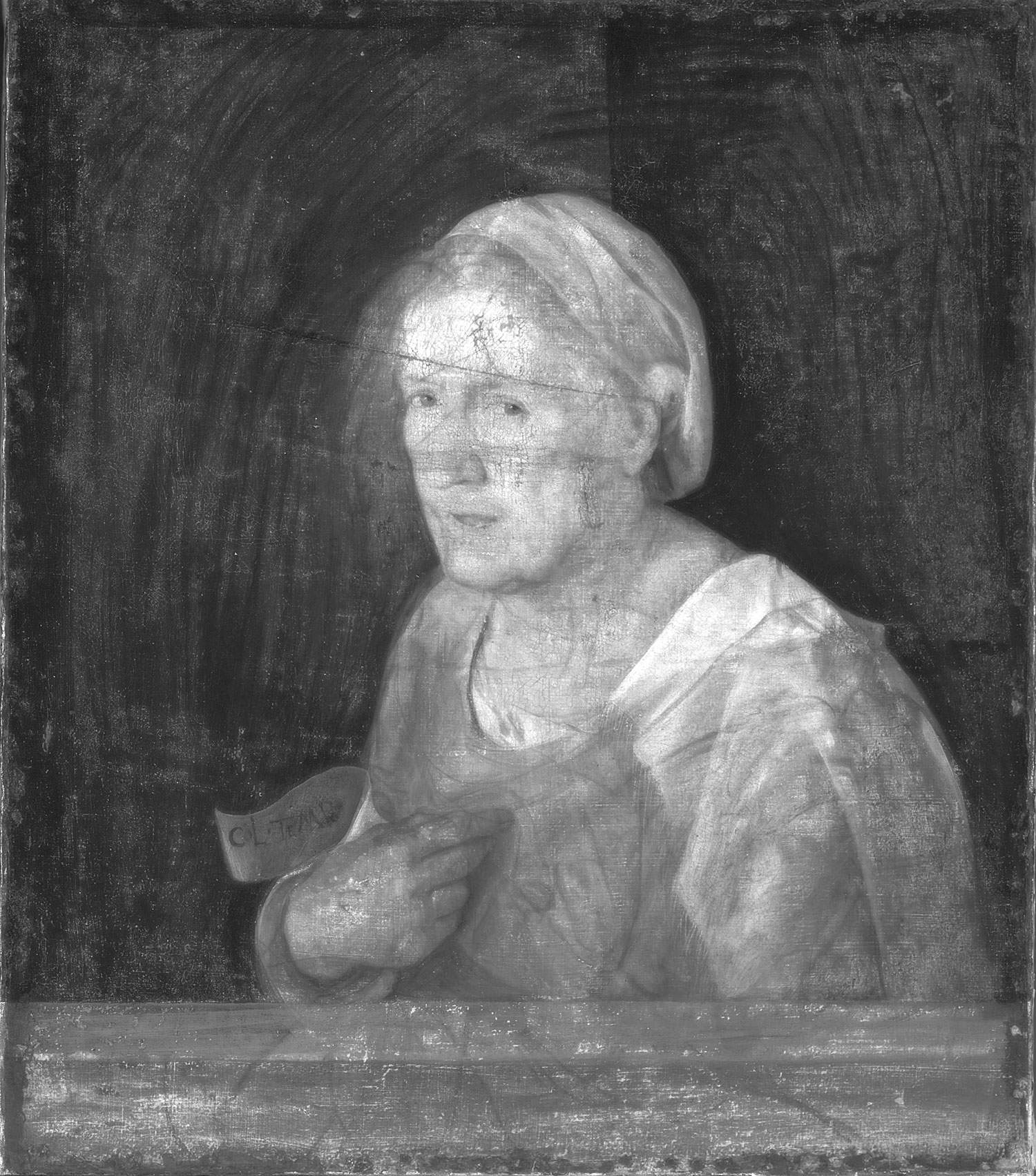 |
| Giorgione, La Vecchia, IR infrared reflectography survey. GAve photo archives - courtesy of Ministero dei beni e delle attività culturali e del turismo, Museo Nazionale Gallerie dellAccademia di Venezia. IR: Ornella Salvadori |
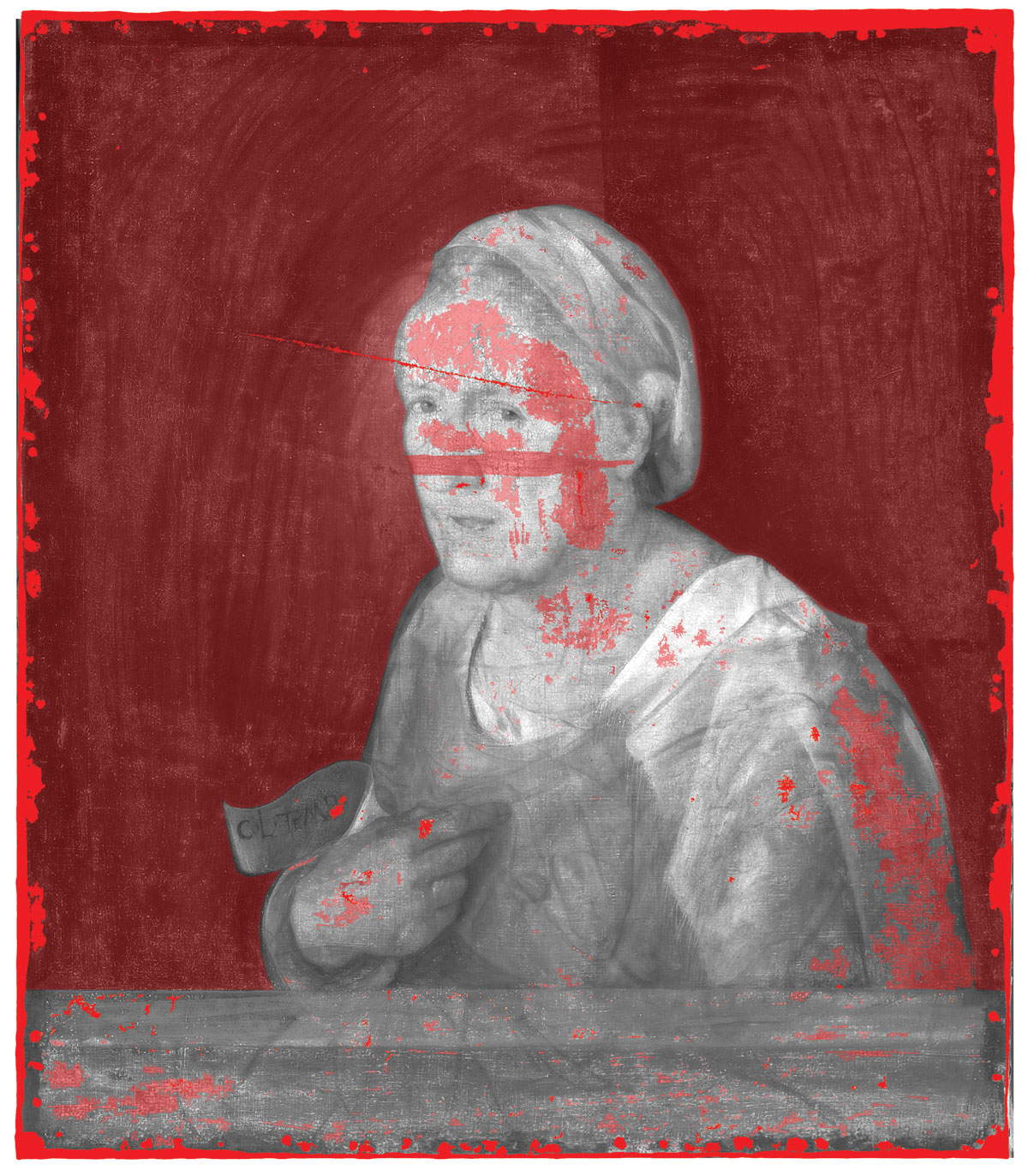 |
| Giorgione, La Vecchia, IR reflectographic image processing - mapping of gaps and abrasions in the paint surface. Opaque red: gaps; transparent red: abrasions. GAve photo archive - courtesy of the Ministry of Cultural Heritage and Activities and Tourism, National Museum Gallerie dellAccademia in Venice. IR Image Processing: Cristiana Sburlino |
The current restoration
From what has been said, it can be seen that the intent of the current restoration was dictated by predominantly aesthetic motivations and aimed at overcoming conservation constraints in order to restore the extraordinary artistic qualities of this masterpiece. Therefore, cleaning and pictorial reintegration operations were carried out. The only intervention on the support was the improvement of the tensioning system with the introduction of springs with continuous thrust in the corners of the wooden frame. Once the surface cleaning of removal of adhering dirt was completed, the controlled removal of the altered varnish was carried out after the usual solubility tests. The pictorial surface was affected by superimposed layers of varnishes characterized by different compositions and solubilization resistance. In light of the fragility of the original paint film, which made it necessary to reduce the mechanical action, a selective but one-step removal procedure was opted for, and to reduce solvent permeation, a thickened mixture was used, reducing the solvent concentration by preliminary comparative micro-tests in multiple formulations.
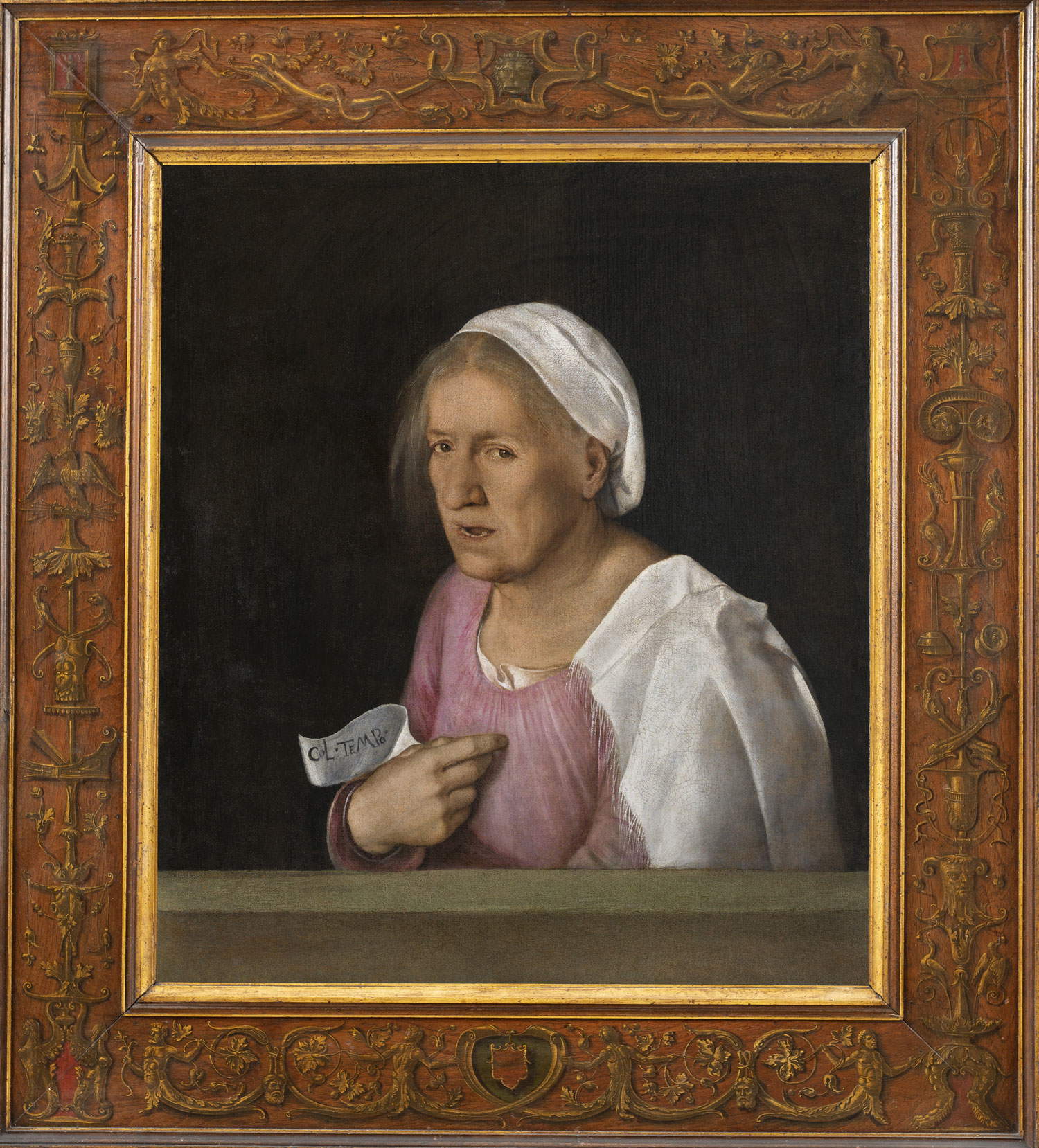 |
| Giorgione, La Vecchia, after restoration (painting on canvas, 68.4 x 59.5 cm; Venice, Gallerie dell’Accademia). GAve photo archive - courtesy of the Ministry of Cultural Heritage and Activities and Tourism, National Museum Gallerie dellAccademia, Venice. Ph. Matteo De Fina |
Once the cleaning was completed, an intermediate brush painting was carried out and then the few gaps were filled in. The retouching proceeded with the aim of restoring legibility to the painting while maintaining the perception of its conservative condition. The abrasions of the incarnations and the white abrasions of the shawl and headdress were lowered in tone. Where the support canvas emerged, it was kept exposed and matched the surrounding color. Reduced locally, selectively, the impact of the crazing to encourage the emergence of the original pictorial layer. Treated in this way particularly the forehead, the left cheek around the eye, some areas of La Vecchia’s shawl and headdress. Minimally reduced the disturbing effect of the diagonal cut in the forehead. The diffuse abrasions of the black background have been lowered so as to be absorbed by the tone of the original fielding, while the black brushstrokes of theabbozzo have been left more visible. Finally, the parapet, heavily abraded by the mechanical cleaning performed by Pellicioli, has been stitched up with transparent micro-veins.
The present restoration reinstated the original characters of this masterpiece that past damage and interventions (the repainting around the eyes and the limpositioning of the shape of the nose) had altered. The aesthetic presentation, while maintaining to the work a suffered character, locally impoverished in the refined original finishes (especially in the face), has allowed it to regain the strong naturalistic and luministic impact that Giorgione had wanted to give it. The chromatic balance, the correct spatial perception as well as the refinement of some pictorial drafts such as the pink robe have been restored.
The recovered reading and appreciation of the concealed pictorial effects is now to the judgment of the public and the critical debate of scholars.
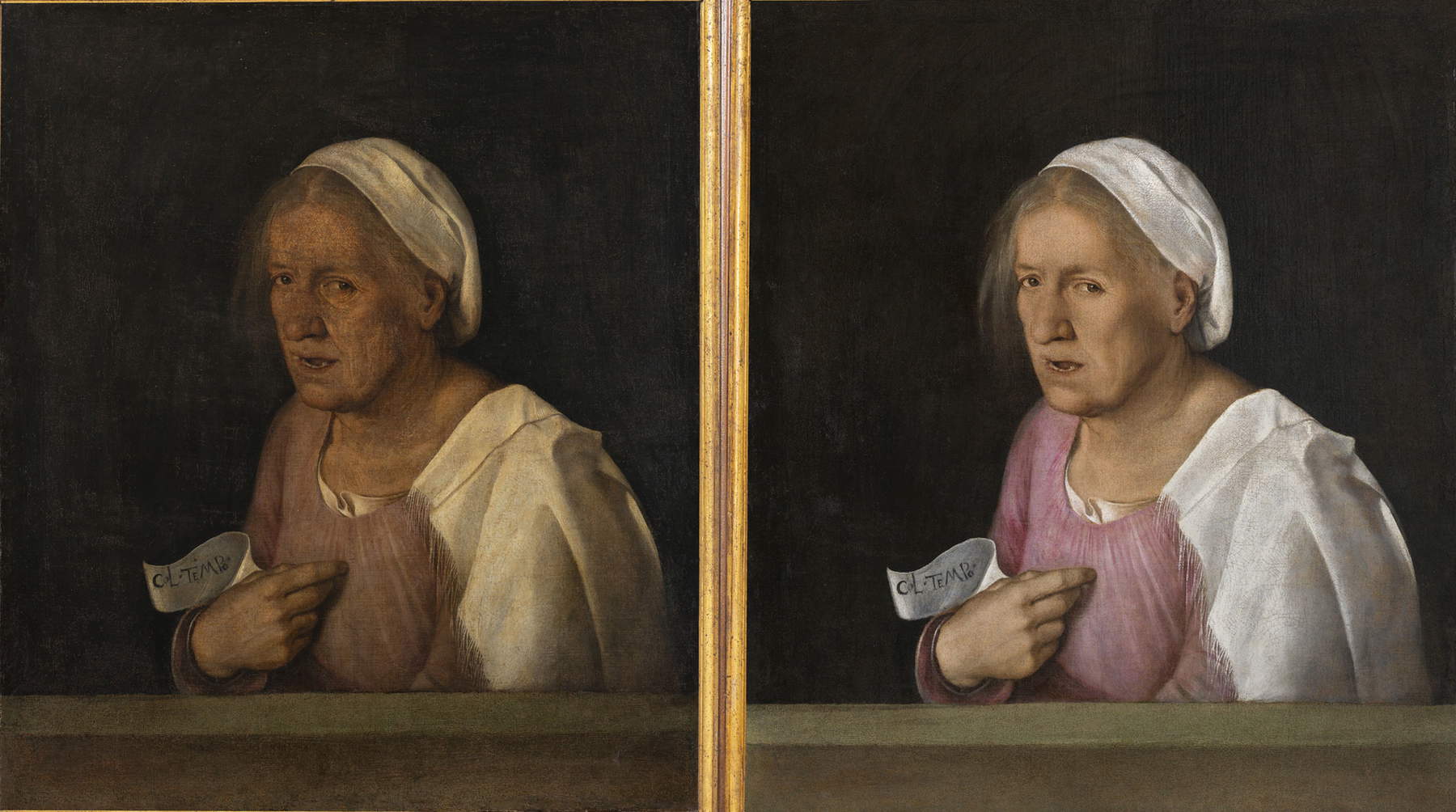 |
| Giorgione, La Vecchia, before and after restoration. GAve photo archive - courtesy of the Ministry of Cultural Heritage and Activities and Tourism, National Museum Gallerie dellAccademia in Venice. Ph. Matteo De Fina |
Warning: the translation into English of the original Italian article was created using automatic tools. We undertake to review all articles, but we do not guarantee the total absence of inaccuracies in the translation due to the program. You can find the original by clicking on the ITA button. If you find any mistake,please contact us.